Sept. 5, 2011
By Lou Somogyi
On Sept. 10, 2011, Notre Dame and Michigan will engage in “something old, something new, something borrowed, something blue.”
The old will be the 28th meeting in their series since its renewal in 1978.
The new will be the first night game in Michigan Stadium history.
Something borrowed will be that both will have “Throwback Night” when they wear retro jerseys from a half-century ago.
As for the blue, Michigan will have its traditional Maize and Blue colors to go with its Block M on the front and arm stripes.
However, Notre Dame will feature a green shamrock on its gold helmets, in addition to a green numeral and green stripes on the shoulder pads and on the white socks. Its uniforms will mirror those donned under former Irish head coach Joe Kuharich (1959-62). Hopefully, that will be the lone resemblance, because the football record over those four seasons was 17-23.
Notre Dame’s official school colors are gold and blue, and the third verse of the Alma Mater states: “Proudly in the heavens, gleams thy Gold and Blue.”
However, green represents a link to the school’s “Fighting Irish” heritage, and will remain an everlasting aspect.
In The Beginning
The first Notre Dame football team in 1887 was garbed in baseball-style uniforms with blue lettering.
Numbers on the back of the jersey were not officially issued to players until 1921, or the year after Irish All-America halfback George Gipp’s senior campaign.
For most of the first 30 years of the 20th century, Notre Dame donned navy blue sweaters with brown pants and the conventional leather helmet. Head coach Knute Rockne’s varsity team wore blue while the freshman squad wore green — as in greenhorns.
There is no official answer on the first time a Notre Dame team appeared in green jerseys, but popular belief is it occurred on Oct. 16, 1926 at Cartier Field against Penn State.
To Notre Dame’s surprise, Penn State came to South Bend in 1926 with blue jerseys, the same color as Notre Dame’s. For the purpose of distinction in the uniforms, the Notre Dame team resorted to wearing the freshman team’s green, which didn’t have any numerals on the back.
Unaware of why Notre Dame was dressed in green, one out-of-town newspaper account criticized the Irish athletic hierarchy for “being too cheap to have numbers on the new jerseys.”
The Irish ended up winning easily, 28-0.
On a couple of occasions during his career, Rockne did use green jerseys as an inspirational vehicle.
In the first Notre Dame-Navy game, held in Baltimore in 1927, Rockne started his “shock troops” (second team) in blue, but Navy immediately went ahead, 6-0.
After the touchdown, George Trevor of the New York Sun reported Notre Dame’s ensuing wardrobe change this way: “Instantaneously the Notre Dame regulars yanked off their blue outer sweaters and like a horde of green Gila monsters darted onto the field. From that moment on Notre Dame held the initiative, imposed its collective will upon the Navy.”
The Irish went on to defeat the Midshipmen 19-6, and wore green again the next year in Chicago’s Soldier Field during a 7-0 conquest of Navy.
“Mr. Rockne may, or may not, be a psychologist,” reported the Notre Dame student magazine Scholastic. “But … Mr. Rockne evidently surmised that garbing a band of native and adopted Irish in their native color is somewhat akin to showing a bull the Russian flag.”
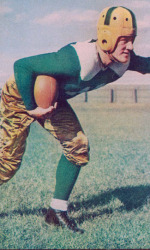
Notre Dame football uniform (c. 1940)
|
Green became a more popular color for Notre Dame in the 1930s. During the Elmer Layden coaching era (1934-40), white yokes were added to the shoulders to provide contrast to the uniform when both teams were still garbed in dark jerseys.
Under head coach Frank Leahy (1941-43, 1946-53), Notre Dame sported blue with no yokes, but after World War II green became favored right through the 1950s. Heisman Trophy winner John Lujack did a photo shoot in the green — with a gold metallic helmet — for the September 1947 cover of Life magazine.
Into A Modern Era
Green remained the Irish staple in the 1950s with Leahy and successor Terry Brennan (1954-58). By Heisman Trophy winner Paul Hornung’s senior season in 1956, the single face guard was added to the helmet.
In 1957 under Brennan, the Irish also wore numbers on the side of their leather helmets, and white road uniforms with green numerals became standard issue in the 1950s.
Notre Dame ushered in its most major changes to the uniform under head coach Joe Kuharich (1959-62).
Blue jerseys became standard — although green was still worn on occasion — with stripes and numbers added to the shoulders, and, most conspicuously, a green shamrock designed on the helmet.
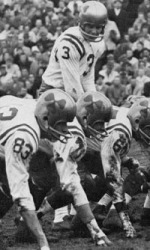
Notre Dame football uniform (c. 1959)
|
At the start of the Kuharich era in 1959, Notre Dame also permanently steered away from what was described as the “Moon Men” look with its leather helmets.
A product of the NFL, Kuharich introduced the smaller metallic helmets worn by most college and pro teams The design of the shamrock looked awkward in 1959, so it changed the next year to look more “right side up.” In 1963 with interim coach Hugh Devore, the shamrock on the helmet was replaced with the individual’s jersey number, and the stripes on the shoulders also were removed. It would mark the final year the numbers would be on the Notre Dame helmet.
In Devore’s final game, a Thanksgiving Day 14-7 loss to Syracuse in Yankee Stadium, Notre Dame donned green.
Blue, Green & Madonna Blue
When he accepted the Notre Dame job, head coach Ara Parseghian (1964-74) asked school vice president Rev. Ned Joyce what the official school colors were. Throughout the 1950s when he was coaching at Miami (Ohio) and Northwestern, Parseghian noticed how the Irish were sometimes in green and other times in blue, so he was a little confused.
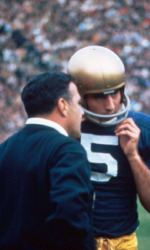
Notre Dame football uniform (c. 1966)
|
“I wanted to get one consistent look for the football team,” Parseghian said.
When Joyce told him that the official school colors were Gold and Blue, Parseghian never wavered from the classic gold helmet, gold pants, and Navy blue jersey look, and two-piece socks (white with blue stripes on the top) were added. On the road, the white jersey had a blue number.
However, one addition Parseghian did implement, although not necessarily at the outset, was blue stars added to the gold helmets.
According to Parseghian, the stars signified a reward for individual or collective excellence and leadership during the course of the season. The stars haven’t been used since 1974, or since Parseghian’s retirement from coaching.
In 1969, when Notre Dame ended its 45-year ban on going to bowl games, another wrinkle was added. In the Jan. 1, 1970 Cotton Bowl versus No. 1 Texas, a 21-17 Irish defeat, last names on the back of the jersey were added.
Interestingly, names on the back were not included the following year in the Cotton Bowl, when Notre Dame ended the No. 1 Longhorns’ 30-game winning streak with a 24-11 victory.
In fact, bowl games were the only times under Parseghian that the names were included on the back of the jersey. Yet even in the epic 24-23 Sugar Bowl triumph against Alabama in 1973 that won Notre Dame the national title, most of the Irish players had their names on the back — but star quarterback Tom Clements, the game’s MVP, did not.
When successor Dan Devine (1975-80) was hired, he made a suggestion to the administration to change the uniform colors back to green because as a former Michigan State assistant in the early 1950s who competed against the Irish, that was the color he always associated with Notre Dame.
“The idea didn’t go over too well,” Devine told Blue & Gold Illustrated in 1986.
With inspiration from Irish basketball coach Digger Phelps, Devine ordered green jerseys in August 1977 for a special occasion, and Notre Dame pulled off one of the great ruses in school history in the Oct. 22, 1977 “Green Jersey Game” against No. 5 USC.
Projected in the pre-season as the team to beat for the 1977 national title, the underachieving Irish sputtered to a 4-1 start.
While the Notre Dame team wore blue during the pre-game warm-ups against USC, Devine had the student managers carry boxes of the new green jerseys into the locker room. Only the four team captains knew what was occurring behind the scenes, and they managed to keep it a secret throughout the week.
When the players returned to the locker room, the bright new green jerseys hung from each player’s locker, and pandemonium ensued. The “Green Machine” unleashed a 49-19 bloodletting against USC and, after averaging only 20.6 points per game during the 4-1 start, it more than doubled to 45.3 points per contest over the last seven, highlighted by a 38-10 victory against No. 1 Texas in the Cotton Bowl to claim the national title.
The USC game was supposed to be a one-time deal before returning to blue. Many players even gave their jerseys to parents to take back home as a souvenir.
But an outcry ensued that the green jerseys were the program’s new good-luck charm, and abandoning them would bring negative karma. The Irish wore green not only for the rest of that championship season, but also in Devine’s final three seasons from 1978-80 (see sidebar).
Two other additions under Devine were names on the back of the jersey throughout his career and white football cleats.
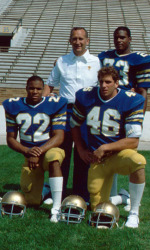
Notre Dame football uniform (c. 1982)
|
When Gerry Faust (1981-85) was named as Devine’s successor, he returned Notre Dame to what was referred to as Madonna Blue, augmented with white and gold sleeve stripes his teams wore at Cincinnati Moeller High. “Blue is the color of the Blessed Mother,” Faust explained. “She’s brought me this far. I’m sticking with Her.”
By 1984, Faust changed the color back to traditional Navy blue. He also did not change the white cleats and names on the back of the jersey throughout the season begun under Devine.
The Last 25 Years
When Lou Holtz (1986-96) took charge as the head coach, speculation was renewed on whether the Irish would revert to green jerseys. In a conversation with University president Rev. Theodore Hesburgh, Holtz was informed the school colors were Gold and Blue.
However, Holtz wasn’t as interested in changing colors as he was in putting an interlocking “ND” on the helmets.
“The helmets represent the Golden Dome,” Hesburgh pointed out to Holtz.
“Well, how about if we paint the Dome?” quipped Holtz.
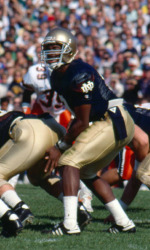
Notre Dame football uniform (c. 1988)
|
The three most conspicuous alterations at the beginning of the Holtz era were 1) switching back to black cleats, 2) adding an interlocking ND on the shoulder sleeves (perhaps a compromise to doing it on the helmet) and 3) removing the names off the back of the jerseys.
It was until the 2008 Hawaii Bowl that head coach Charlie Weis revived the names on the back only for the bowl game, and Brian Kelly did the same in the 2010 Sun Bowl.
In 2001-02 under coaches Bob Davie (1997-2001) and Ty Willingham (2002-04), adidas replaced Champion as the uniform manufacturer for the Irish.
The Notre Dame jersey became quite “busy” at the turn of the 21st century, especially the road white jersey that included a broad gold stripe down the sides, an adidas logo on the right shoulder pad, the American flag on the left shoulder pad (in honor of 9/11), a green shamrock at the V neck, “Irish” just above the jersey number and a green shamrock with an interlocking ND on the left thigh.
Notre Dame’s most recent jerseys with Kelly include the adidas logo in the middle of the jersey and above the right thigh, a large interlocking ND on the shoulder sleeves, and a smaller interlocking ND above the left thigh.
“Going Green”
What is Notre Dame’s record in green jerseys since it was reintroduced during the 1977 national title season?
Under Dan Devine from 1977-80, it was 32-9-1.
Gerry Faust (1981-85) was 2-0, both times against USC: 27-6 in 1983 and 37-3 in 1985, when the Irish wore green only in the second half after already taking a 27-0 halftime lead.
Under Lou Holtz (1986-96), the record was 1-1. The Irish never wore green at home, but did have green socks and green numerals on their white jerseys during a 39-28 upset of No. 3 Florida in the 1992 Sugar Bowl. A heavy underdog against No. 4 Colorado in the Jan. 1, 1995 Fiesta Bowl, Holtz tried the green-jersey ploy for his unranked 6-4-1 team, but the Irish were clearly outmatched in a 41-24 defeat.
The only time it was worn under Bob Davie (1997-2001) was the Jan. 1, 1999 Gator Bowl versus Georgia Tech, a 35-28 Irish loss.
Under Tyrone Willingham (2002-24), his era began with a sterling 8-0 ledger. He then opted to wear green for the 2002 Boston College game that resulted in a 14-7 defeat. Contrary to 1977, green was beginning to be perceived as “bad luck” for the Irish.
With Charlie Weis (2005-09), Notre Dame was 1-2 in green and began with a 34-31 loss in the epic 2005 clash with No. 1 USC. A four-game losing streak in green was finally snapped with a 41-9 victory against Army in the 2006 home finale. The green wardrobe was used one more time by Weis against USC in 2007 — the 30th anniversary of the original — but resulted in a 38-0 loss.
Brian Kelly’s Irish debut in green produced a 27-3 victory against Army last Nov. 20 in Yankee Stadium.
Thus, the overall record in green since 1977 is 37-14-1 (.721).
The surprise element from 1977 is long gone, but “going green” every now and then will likely be a natural part of the school’s fabric, literally and figuratively.
Lou Somogyi is the senior editor of Blue & Gold Illustrated.
–ND–







